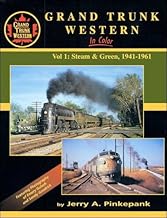This website has been archived from TrainWeb.org/jerrypinfo to TrainWeb.US/jerrypinfo.
This website has been archived from TrainWeb.org/jerrypinfo to TrainWeb.US/jerrypinfo.
GRAND TRUNK WESTERN
VOL. 1 STEAM AND GREEN
GENERAL CORRECTIONS AND ADDITIONS

Click Here For More Info Including Where To Purchase
Remarks initiated March 13, 2004
The book design is by Catherine Nemitz of Morning Sun, who also created (from a rather fussy pencil drawing I furnished) the very legible and effective South Bend map, used initially in the NYC Western Division book and slightly revised here.
p.8 Fr. Michael Ruthenberg, O.P., of Chicago, who is doing very useful research on details of the appearance of the U-4-b's which he is sharing with model builders, reminds me that Lima referred to the natural metal jackets of the 6400's as "planished steel" rather than Russia Iron. I believe the process was the same, beating the metal until it acquired a low gloss. This finish was then brought to a high gloss by regular wiping with oiled rags. It was this labor-intensive procedure that GTW soon avoided by painting the jacket and skyline casing black (see also p. 118) A glimpse of this shade of gray is visible on p. 46, on the small portion of the jacket not in shadow of 6405's smoke, but as can be judged from the condition of the engine overall, the oily wipedown that would have produced a high gloss has been missing for some time in the stresses of 1943.
p. 31 Andrew Falconer calls attention to the fact that the Little Brothers grain elevator in the picture on pages 30-31, which was identified on the slide as being taken in Vicksburg, appears to be the one in Schoolcraft, MI rather than Vicksburg. I have checked details of the track, namely the direction of curvature, and confirmed that this is, indeed, Schoolcraft.
p. 36 The gable roof building identified in the caption is not the system storehouse but is the office and storehouse for the roundhouse. The system storehouse (and system mechanical and store department office building) is, instead, the one correctly identified on page 35, adjacent to the backshop.
p. 46 Note that between the headlight of 6405 and the brass number plate, there is a small nut. This capped a retaining bolt which was applied to the U-4-b's by the railroad, and Fr. Ruthenberg (see remark for p. 8) points out that the absence of this nut is an identifier for very early pictures of the U-4-b's.
p.73 The reference to Fort Gratiot car shop is wrong; that shop burned in 1913 and was about two miles north of its replacement, the Port Huron Car Shop. Fort Gratiot was the location of the old ferry crossing before the first St. Clair Tunnel opened in 1891. It was then stranded on a spur north of the new main line to the tunnel. The new shop was built adjacent to the new main line. See GTW vol. 2, p. 59.
p.75 see note for p. 73 concerning Ft. Gratiot shops.
p. 109 I am reminded by Dennis McNeil that 4070 has a Coffin feedwater heater, the only S-3-a so equipped. Although Coffin heaters were widely used on the Central Vermont, they were not common elsewhere on the CNR system, GTW 1929 Pacifics 5632-5634 being among the few other examples.
p.118 See note regarding page 8., above.
p.121 Dennis McNeil advises that during this period a Royal Oak turn was operating from Milwaukee Junction, normally using a 3700, and also, his notes show a number of instances of doubleheading in this period, interspersed with instances where a separate Pontiac turn was run. We have not been able to figure out why they would double head one day and run a separate turn the next. It may have been an issue of allowable trailing tonnage although with steam power GTW's tonnage tables simply added together the rating of the two engines and it is hard to get a knuckle from a steam doubleheader on this relatively light grade.